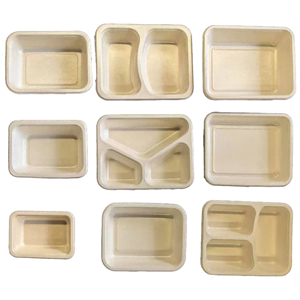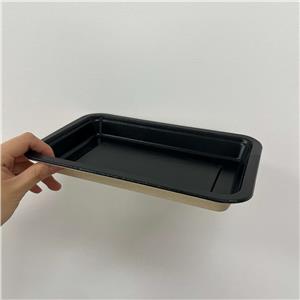Can I Recycle Black Plastic Food Trays? New Solutions Emerge
The Black Plastic Recycling Dilemma
Black plastic food trays, commonly used for ready meals, sushi, and takeout packaging, have long posed a recycling challenge. Traditional black plastics contain carbon-based pigments that absorb infrared light, rendering them invisible to sorting machines at recycling facilities. As a result, an estimated 85% of these trays end up in landfills or incinerators globally, according to a 2023 report by the Ellen MacArthur Foundation.
However, innovations in material science and sustainable design are offering promising alternatives—including sugarcane-based trays with black coatings—that could finally break the cycle of waste.
Why Black Plastic Recycling Fails
Technical Limitations: Near-infrared (NIR) sorting systems cannot detect traditional black plastics, causing contamination in recycling streams.
Low Recovery Rates: Less than 15% of black plastic food packaging is recycled in regions without advanced sorting infrastructure.
Toxic Risks: Some black plastics contain heavy metals or non-recyclable composites, further complicating disposal.
The Rise of Sugarcane-Based Trays with Black Coatings
A groundbreaking solution gaining traction is the use of sugarcane bagasse trays coated with plant-based black films. These trays address both aesthetic and environmental concerns:
Fully Compostable: Made from sugarcane fiber (a byproduct of sugar production) and coated with biodegradable black films derived from cornstarch or algae, these trays break down in industrial composting facilities within 12 weeks.
NIR-Compatible: Unlike traditional carbon-black plastics, the plant-based coatings allow infrared detection, enabling proper sorting if accidentally mixed with recyclables.
Carbon-Negative Production: Sugarcane absorbs CO2 as it grows, offsetting emissions from manufacturing. A 2023 study by the European Bioplastics Association found sugarcane trays reduce carbon footprints by 68% compared to fossil-fuel plastics.
Case Study: UK-based startup EcoWare launched black-coated sugarcane trays in 2023 for supermarket meal kits. Trials showed a 90% composting rate and 40% lower production costs than PLA bioplastics.
How Consumers Can Act
Check Labels: Look for certifications like "OK Compost" or "ASTM D6400" to verify biodegradability.
Demand Clarity: Encourage brands to adopt plant-based black coatings instead of traditional plastics.
Dispose Correctly: If sugarcane trays are used, compost them industrially (home compost systems may lack sufficient heat).
Industry Shifts and Challenges
While sugarcane trays show promise, barriers remain:
Scalability: Global sugarcane bagasse production must expand to meet packaging demand.
Cost: Plant-based films currently cost 20% more than synthetic coatings, though prices are falling.
Policy Gaps: Few countries mandate compostable packaging, creating market fragmentation.
The EU’s upcoming Packaging and Packaging Waste Regulation (2024) may drive change by requiring all food trays to be recyclable or compostable by 2030.
Expert Insight
Dr. Lena Müller, a circular economy researcher at TU Berlin, notes: “Sugarcane trays with functional coatings are a transitional bridge to zero-waste systems. For true sustainability, we must pair material innovation with reusable container programs.”
The Bottom Line
While traditional black plastic trays remain problematic, sugarcane-based alternatives offer a viable path forward. As consumers and regulators push for greener options, the humble food tray is finally getting a much-needed eco-makeover.
For more information on composting facilities near you, visit Biodegradable Products Institute or [Local Government Recycling Guides].




